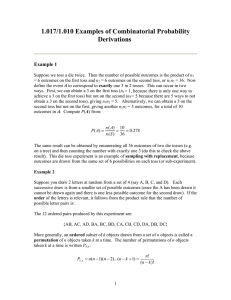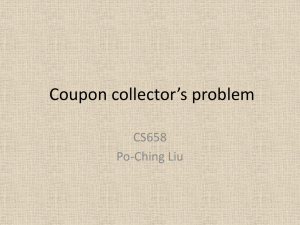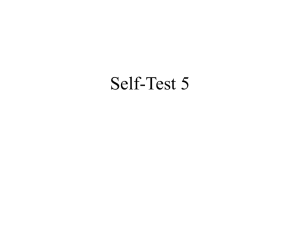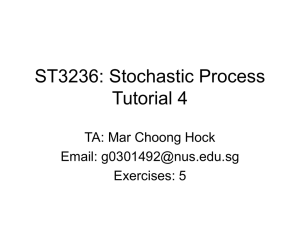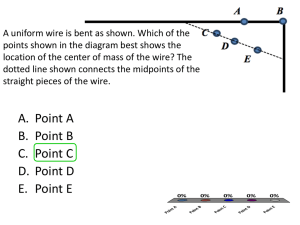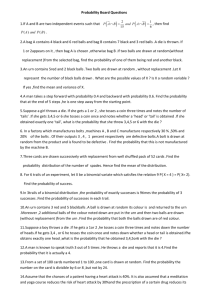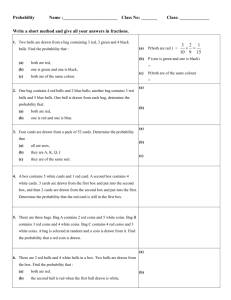1.017 Class 11 Methods for Deriving Probabilities
advertisement
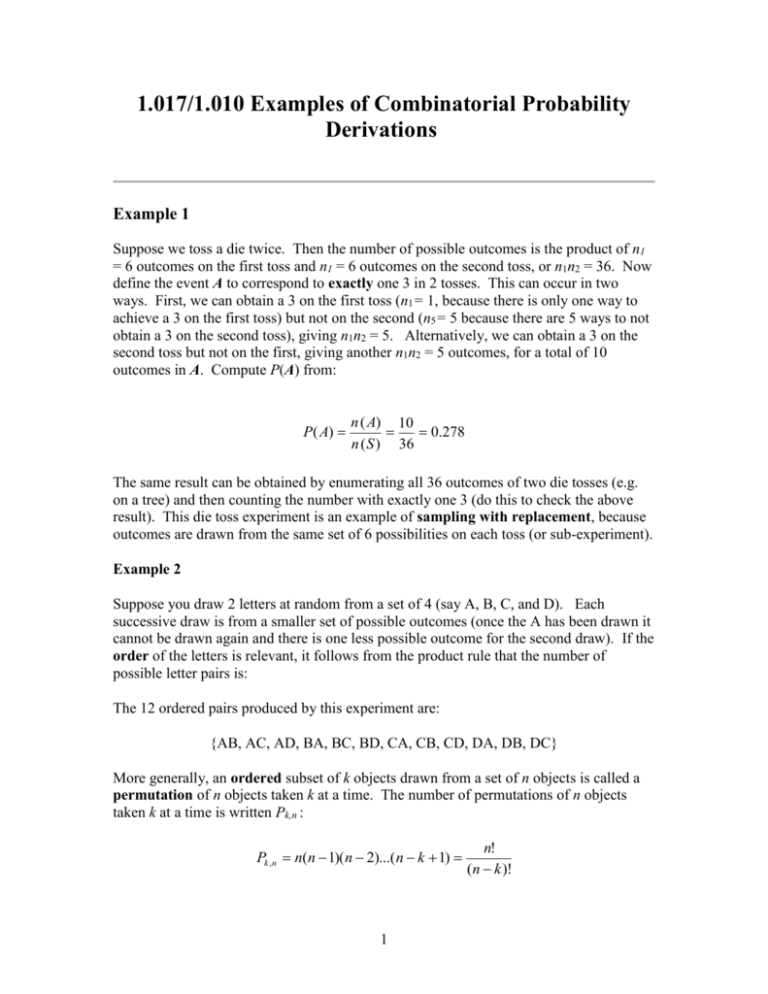
1.017/1.010 Examples of Combinatorial Probability
Derivations
Example 1
Suppose we toss a die twice. Then the number of possible outcomes is the product of n1
= 6 outcomes on the first toss and n1 = 6 outcomes on the second toss, or n1n2 = 36. Now
define the event A to correspond to exactly one 3 in 2 tosses. This can occur in two
ways. First, we can obtain a 3 on the first toss (n1= 1, because there is only one way to
achieve a 3 on the first toss) but not on the second (n5= 5 because there are 5 ways to not
obtain a 3 on the second toss), giving n1n2 = 5. Alternatively, we can obtain a 3 on the
second toss but not on the first, giving another n1n2 = 5 outcomes, for a total of 10
outcomes in A. Compute P(A) from:
P( A)
n ( A) 10
0.278
n ( S ) 36
The same result can be obtained by enumerating all 36 outcomes of two die tosses (e.g.
on a tree) and then counting the number with exactly one 3 (do this to check the above
result). This die toss experiment is an example of sampling with replacement, because
outcomes are drawn from the same set of 6 possibilities on each toss (or sub-experiment).
Example 2
Suppose you draw 2 letters at random from a set of 4 (say A, B, C, and D). Each
successive draw is from a smaller set of possible outcomes (once the A has been drawn it
cannot be drawn again and there is one less possible outcome for the second draw). If the
order of the letters is relevant, it follows from the product rule that the number of
possible letter pairs is:
The 12 ordered pairs produced by this experiment are:
{AB, AC, AD, BA, BC, BD, CA, CB, CD, DA, DB, DC}
More generally, an ordered subset of k objects drawn from a set of n objects is called a
permutation of n objects taken k at a time. The number of permutations of n objects
taken k at a time is written Pk,n :
Pk ,n n(n 1)( n 2)...( n k 1)
1
n!
(n k )!
This number can be used to count simple events that result from sampling without
replacement experiments where sampling order is important. The MATLAB function
factorial(n) can be used to evaluate Pk,n for relatively small n.
If the order in which objects are drawn in sampling without replacement is not relevant
the number of possibilities decreases. In our example, if order is ignored in our letter
example the pairs AB and BA, AC and CA, AD and DA, BC and CB, BD and DB, CD
and DC are equivalent. The number of equivalent pairs obtained when order is ignored is
the number of permutations (12) divided by the number of ways the same two letters can
be arranged ( n = n1·n2 = 2·1=2). Consequently, the number of equivalent unordered
pairs is 12/2 = 6.
More generally, an unordered subset of k objects drawn a set of n objects is called a
combination of n objects taken k at a time. The number of combinations of n objects
taken k at a time is Ck,n
C k ,n Pk ,n / P1,k
n!
k!(n k )!
The k! in the denominator is the number of ways that the k objects can be arranged
among themselves (i.e. P1,k). The MATLAB function nchoosek(n,k) evaluates
Ck,n.for relatively small n.
Example 3
Suppose that a box contains:
8 red balls
3 white balls
9 blue balls
3 balls are drawn without replacement. The sample space consists of all possible
arrangements of three balls that can be drawn from the box. Since order is unimportant
this implies that the total number of outcomes in the sample space is the number of
combinations of 20 balls taken 3 at a time:
Total outcomes = n(S) = C3,20 =1140
Find the probabilities of the following events in the sample space using combinatorial
and virtual experiment (Monte Carlo) approaches. The MATLAB function balls carries
out the virtual experiment.
a) Probability that all 3 balls are red.
2
The number of outcomes in the event A = "all 3 balls are red" is the number of possible
ways to draw 3 balls from the supply of 8 red balls. This is the number of combinations
of 8 red balls taken 3 at a time:
Outcomes in A = n(A) = C3,8 = 56
The probability of the event is therefore:
P( A)
C
C
3,8
3,20
56
0.049
1140
b) Probability that at least 1 ball is white
For events involving "at least one" specifications it is usually best to begin by considering
the complementary event "none". The number of outcomes in the event A' = "no balls are
white" is the number of possible arrangements of 17 nonwhite balls taken 3 at a time:
Outcomes in A' = n(A') = C3,17 = 680
Consequently the probability of this event is:
P( A)
C
C
3,17
3,20
680
0.596
1140
And the probability of the complementary event A = "at least one white ball" is:
P( A) 1
680
0.404
1140
c) Probability that 2 balls are red and 1 ball is white
This is an example of an event A resulting from 2 actions (Action 1 is selection of 2 red
balls and Action 2 is selection of 1 white ball). From the product rule the number of
combinations resulting from both actions is:
Outcomes in A = n(A) = (C2,8)(C1,3) = (28)(3) = 84
The probability is therefore:
C
C
84
2,8 1,3
P( A)
0.074
C
1140
3,20
3
d) Probability that 1 ball is red, 1 ball is white, and 1 ball is blue
This is basically the same problem as c). The event A now consists of 3 actions (Action 1
is the selection of 1 red balls, Action 2 is the selection of 1 white ball, and Action 3 is the
selection of 1 blue ball). From the fundamental principle of counting the number of
combinations resulting from all three actions is:
Outcomes in A = n(A) = (C1,8)(C1,3)(C1,9) = (8)(3)(9) = 216
The probability of A is therefore:
C C C
216
1,8 1,3 1,9
P( A)
0.189
C
1140
3,20
Example 4
Suppose we draw 4 cards from a well-shuffled deck of 52 cards. What is the probability
of obtaining exactly 2 aces? Use combinatorial and virtual experiment methods.
Here the sample space S consists of all 4-card hands that can be constructed from a deck
of 52 cards. Since the cards are drawn without replacement and order is not important the
total number of outcomes in the sample space is the number of combinations of 52 cards
taken 4 at a time:
Total outcomes in S = C4,52 = 270,725
The event A results from two actions – Action 1 is the selection of 2 aces and Action 2 is
the selection of 2 cards that are not aces. There are C2,4 ways to obtain 2 aces out of 4 in
the deck and C2,48 ways to obtain 2 non-aces from the remaining 48 cards. Consequently
the product rule tells us that the total number of ways to obtain exactly 2 aces is:
Outcomes in A = n(A) = (C2,4)(C2,48) = (6)(1128) = 6768
The probability is therefore:
P( A)
C
C
6768
2,4 2,48
0.025
C
270,725
4,52
Example 5
A shelf has 6 math books and 4 physics books that have been placed there at random.
Find the probability that 3 particular math books will be grouped together (adjoining),
using both combinatorial and virtual experiment methods.
4
Here it is convenient to define the sample space S to be all possible arrangements of the
math books, with order considered (because the books must be adjoining). The number
of ordered outcomes in this space is the number of permutations of 10 books arranged in
10 locations:
Total outcomes in S = P10,10 = 10! = 3,628,800
Now treat the 3 adjoining math books as one group and each of the other 7 books as a
distinct group, giving a total of 8 groups. The number of ways for Event A to occur is the
number of ways that these 8 groups can be arranged in the 8 "spaces" on the shelf.
Considering order, this is P8,8. For each of these arrangements there are P3,3 ways to
arrange the 3 books. Consequently, the total number of ways to obtain the specified
event is:
Outcomes in A = n(A) = (P3,3)(P8,8) = (3!)(8!) = (6)(40320) = 241,920
The probability is therefore:
P( A)
P P
241,920
3,3 8,8
0.0667
P
3,628,800
10,10
Example 6
What is the probability of obtaining exactly 3 "6’s" in 5 tosses of a single fair die?
both combinatorial and virtual experiment methods.
Use
This experiment mixes aspects of sampling with and without replacement. The sample
space S consists of 65 possible outcomes from the 5 rolls (sampling with replacement):
Total outcomes in S =65 = 7776
As in earlier examples, the event A results from 2 actions, Action 1 being the roll of 3
"6’s" and Action 2 being the roll of 2 other numbers (not "6's"). Since order is not
important there are 5C3 ways to obtain the 3 "6’s" (sampling without replacement). There
are 52 ways to obtain results other than 6 on the remaining 2 tosses (sampling with
replacement). Consequently, the total number of ways to obtain the specified event A is:
Outcomes in A = (C3,5)(52) = 250
The probability is therefore:
P( A)
C
3,5
(5) 2
(6) 5
5
250
0.032
7776
